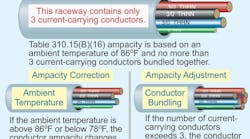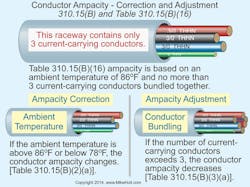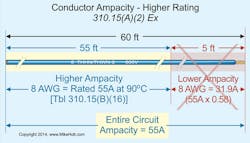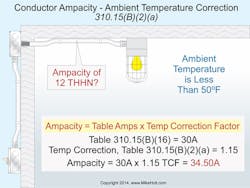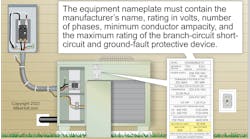Unfortunately, making the proper choices when sizing electrical conductors can get complicated. For one thing, the ampacity tables can be very confusing — especially if you don’t understand the “why” behind them and the correction factors you will most likely apply when using them.
A key factor is impedance, which is the opposition to current flow. In DC circuits, we call it “resistance.” Whenever current (I) flows through a conductor, the opposition (R) to current flow produces heat. We call this current resistance heating “IR heating.”
If you increase the current flow, you get more heat. The increase in heating (for a given impedance) is directly proportional to the square of the current flow. A complicating factor is that as a conductor heats up, its impedance also increases.
To determine what size conductor is sufficient to safely carry a given amount of current, you must account for IR heating and for the ability of the conductor to dissipate this heat. The number of current-carrying conductors in raceway affects dissipation ability, as does the surrounding temperature.
Conductor heating
The temperature rating of a conductor is the maximum temperature (anywhere along its length) that the conductor can withstand over a prolonged period without experiencing serious degradation [310.15(A)(3), Note 1]. The main factors to consider for conductor operating temperature are:
• Ambient temperature.
• Heat generated internally from current flow through the conductor.
• The rate at which heat can dissipate.
• Adjacent load-carrying conductors.
If the conductor carries excessive current, then the IR heating within the conductor can damage the conductor’s insulation or even melt the conductor itself.
The ampacity of a conductor is the maximum current a conductor can carry continuously, under the conditions of use, without exceeding its temperature rating. Table 310.15(B)(16) lists conductor ampacities under the condition of no more than three current-carrying conductors bundled together in an ambient temperature of 86°F (30°C). The reason for “no more than three” is because when you go above that number each additional conductor diminishes the heat dissipation abilities of all conductors in the raceway.
Ampacity correction and adjustment
Ampacity correction (ambient temperature) [Table 310.15(B)(2)(a)] and adjustment (bundling) [Table 310.15(B)(3)(a)] factors are based on the ampacity rating of the conductor insulation per Table 310.15(B)(16) (Fig. 1).
When determining conductor ampacity under the condition where the ambient temperature is not 86°F (30°C) or the raceway contains no more than three current-carrying conductors, we must use the ampacity listed in the 90°C column of Table 310.15(B)(16).
When conductors are installed in an ambient temperature other than 78°F to 86°F, you must use the multipliers listed in Table 310.15(B)(2)(a) to correct the ampacities listed in Table 310.15(B)(16).
The higher insulation temperature rating of 90°C rated conductors provides a greater conductor ampacity for use in ampacity correction and adjustment, even though you must size conductors based on the column that corresponds to the temperature listing of the terminals [110.14(C)(1)].
Where more than one ampacity applies for a given circuit length, you must use the lowest ampacity value [310.15(A)(2)]. But you can use a higher ampacity for the entire circuit if the reduced ampacity length doesn’t exceed 10 ft or 10% of the length of the higher ampacity (whichever is less) [310.15.(A)(2) Ex] (Fig. 2). Here’s the ambient temperature correction formula:
Corrected Ampacity = (Table 310.15(B)(16) Ampacity) × (Ambient Temperature Correction Factor [Table 310.15(B)(2)(a)])
Solving some example problems will help you see how this works.
Example Problem No. 1
What’s the ampacity of a 12 THHN conductor installed in an ambient temperature less than 50°F (Fig. 3)?
The conductor ampacity for 12 THHN is 30A, at 90°C [Table 310.15(B)(16)]. The correction factor for a 90°C conductor installed in an ambient temperature of 50°F or less is 1.15 [Table 310.15(B)(2)(a)]. Therefore, we solve as follows:
Corrected Ampacity = 30A × 1.15 = 34.40A
Note that the ampacity increases when the ambient temperature is less than 30°C (86°F).
Example Problem No. 2
What’s the ampacity of a 6 THWN-2 conductor when installed outdoors in an ambient temperature of 115°F?
The conductor ampacity for 6 THWN-2 is 75A, at 90°C [Table 310.15(B)(16)]. The correction factor for a 90°C conductor installed in an ambient temperature of 115°F is 0.82 [Table 310.15(B)(2)(a)]. Therefore, we solve as follows:
Corrected Ampacity = 75A × 0.82 = 61.50A
Note that the ampacity decreases when the ambient temperature is greater than 30°C (86°F).
Example Problem No. 3
What’s the ampacity of 3/0 THHN conductors if the ambient temperature is 108°F?
The conductor ampacity for 3/0 THHN is 225A, at 90°C [Table 310.15(B)(16)]. The correction factor for a 90°C conductor installed in an ambient temperature of 108°F is 0.87 [Table 310.15(B)(2)(a)]. Therefore, we solve as follows:
Corrected Ampacity = 225A × 0.87 = 196A.
Bundling adjustments. Bundling more than three conductors in the same raceway degrades the ability of each conductor to dissipate heat, requiring you to adjust the ampacity downward, accordingly.
Here’s the conductor bundling adjustment formula:
Adjusted Ampacity = (Table 310.15(B)(16) Ampacity) × (Bundling Adjustment Factor [Table 310.15(B)(3)(a)])
Again, let’s run through some example problems to show you how this works.
Example Problem No. 1
What’s the adjusted ampacity of four 12 THWN-2 conductors in a raceway (Fig. 4)?
12 THWN-2 is rated 30A at 90°C [Table 310.15(B)(16)]. The adjustment factor for four current-carrying conductors is 0.80 [Table 310.15(B)(3)(a)]. Thus, the adjusted ampacity is calculated as follows:
Adjusted Ampacity = 30A × 0.80 = 24A.
Example Problem No. 2
What’s the adjusted ampacity of four 1 THWN conductors in a raceway?
1 THWN is rated 130A at 90°C [Table 310.15(B)(16)]. The adjustment factor for four current-carrying conductors is 0.80 [Table 310.15(B)(3)(a)]. Therefore, the adjusted ampacity is calculated as follows:
Adjusted Ampacity = 130A × 0.80 = 104A.
Example Problem No. 3
What’s the adjusted ampacity of 10 THHN conductors when nine current-carrying conductors are installed in a raceway or cable?
10 THHN is rated 40A at 90°C [Table 310.15(B)(16)]. The adjustment factor for nine current-carrying conductors is 0.70 [Table 310.15(B)(3)(a)]. Therefore, the adjusted ampacity is calculated as follows:
Adjusted Ampacity = 40A × 0.70 = 28A.
The Table 310.15(B)(3)(a) adjustment factors apply only when you bundle more than three current-carrying conductors. Naturally, all phase conductors are considered current carrying, but what about other conductors?
When more than 30 current-carrying conductors are installed in any cross-sectional area of the wireway, you must use Table 310.15(B)(3)(a) to adjust the conductor ampacity listed in Table 310.15(B)(16) [376.22(B)].
The ampacity of a conductor is based on the “conditions of use” [100]. Table 310.15(B)(16) contains the allowable ampacities for insulated conductors, where no more than three current-carrying conductors are bundled together, based on ambient temperature of 30°C (86°F).
You must correct the allowable ampacity listed in Table 310.15(B)(16), if either:
• The ambient temperature isn’t 86°F from Table 310.15(B)(2)(a).
• There are four or more current-carrying conductors bundled together per the factors contained in Table 310.15(B)(3)(a).
Staying neutral
These factors help determine if you should consider the neutral conductor to be a current-carrying conductor for ampacity adjustment [310.15(B)(5)]. The neutral conductor of a:
• 3-wire, single-phase, 120/240V system, or 4-wire, 3-phase, 120/208V or 277/480V wye-connected system, isn’t considered a current-carrying conductor for conductor ampacity adjustment of 310.15(B)(3)(a) if it carries only the unbalanced current.
• 3-wire circuit of a 4-wire, 3-phase, wye-connected system carries about the same current as the line-to-neutral load currents of the other conductors and is considered a current-carrying conductor [310.15(B)(5)(b)]. In such a situation, one of the line-to-neutral currents isn’t present and can be zeroed out of the neutral current formula.
• 4-wire, 3-phase, 120/208V or 277/480V wye-connected system is considered a current-carrying conductor for conductor ampacity adjustment [310.15(B)(3)(a)] if more than 50% of the neutral load consists of nonlinear loads.
And
• In two-wire circuits, the neutral and ungrounded conductors actually carry current — and you count both as current carrying.
• You don’t count grounding and bonding conductors [310.15(B)(6)].
There’s more
All of this seems like quite a bit of work just to size conductors, doesn’t it? As we said at the outset, it’s complicated. And it gets even more complicated because there are additional rules for feeders, taps, and branch circuits. We’ll cover those in Part 2.
Holt is the owner of Mike Holt Enterprises, Inc. in Leesburg, Fla. He can be reached at www.mikeholt.com.
